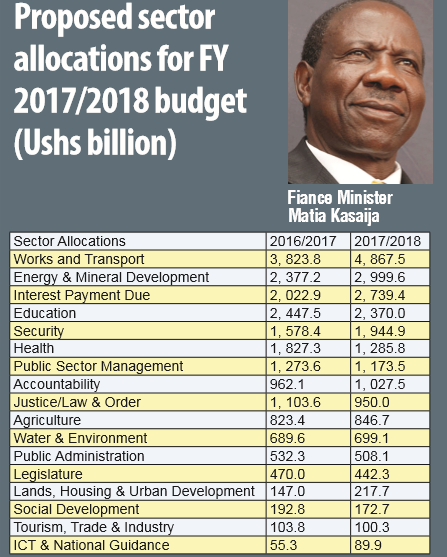
Government’s total external resource inflows are projected to amount to US$ 1,945.7 million (Shs7 trillion) next financial year. Of this, US$ 1,936.5 million (Shs6.96trillion) (99.5%) will take the form of project support, while the remainder of US$ 9.2 million (Shs33billlion) (0.5%) will be in form of budget support.
This implies that pressure will now be on the Uganda Revenue Authority, which government wants it to increase tax collection to Shs14.5 trillion, from the Shs13.2trillion target it had set in the current financial year.
And as a measure to reduce internal borrowing and ease competition with the private sector, the BFP says domestic borrowing is projected to decline to Shs 843 billion in FY 2018/19 and decline further to Shs 485 billion by FY 2020/21.
The next financial year is anchored on the Second National Development Plan (NDPII) that seeks to strengthen Uganda’s competitiveness for sustainable wealth creation, employment and inclusive growth.
Commenting on the proposed budgetary allocations, James Tweheyo, the general secretary of the Uganda National Teachers Union (UNATU) said he entirely blames the education ministry for the government’s proposal to cut its budget allocation.
“I think the ministry of education officials lacks a clear strategy or direction regarding planning, design and execution of projects,” he said, “Which is why government sees no reason of increasing their budgets annually.”
He bases his argument on the fact that the Ministry of Education and Sports was on the spot last year after reports emerged that they had failed to spend a grant of $100 million (Shs 336billion) from the Global Partnership for Education programme administered jointly by the World Bank and the African Development Bank, and donors threatening to withdraw funding ahead of the deadline set for this year – 2017. The grant was meant to build 200 schools countrywide.
Tweheyo said the ministry needs to improve on its operational gaps to attract funding for serious work and avoid being causalities of budgetary cuts.
Why the selected sectors as priorities for FY 2017/18 budget
The government says the budget for FY2017/18 is prioritising public infrastructure investments to facilitate private sector development and enhance the productive capacity of the economy.
The government is projecting the economy to grow at 5.5% in the next financial year and 6% in the FY2018/19 compared with 5% projected growth this year.
Domestic revenues are projected to increase in each of the next five fiscal years. It is projected at Shs 14.5 trillion in the next financial year, Shs 16.6 trillion in 2018/19 and further to 24.1 trillion by 2021/22.
These projections are projected to be driven by reforms in the tax system and efficiency in tax administration, and will require investments in equipment and human resources.
However, the projections exclude any new policy measures that might jeopardize revenue mobilization.
Badagawa said there is need to increasingly work on formalizing the economy to up the country’s tax-to GDP ratio that has been stuck at 13%.
“When you do that you will be able to collect more revenues and increase resources to fund the national budget without waiting for external support,” he said.
He added that the unpredictable external economic and political environment means that Uganda has to prudently use its local resources and avoid wasteful expenditure for better service delivery.
Interest repayments & gov’t expenditure
The BFP notes that government’s interest payments are projected to reach Shs 2.7 trillion for the next financial year, of which Shs 2 trillion is interest on domestic securities and the rest is interest on external debt.
This overall figure represents an increase of 24.8 % as compared to the projected outturn this financial year, and constitutes 9.1% of total resources available for spending.
Going forward, government says the implementation of the infrastructure projects will be more gradual to ensure consistency with the requirements to meet the East African Monetary Union convergence criteria.
It defends recurrent expenditure as a percentage of GDP which it says is projected to remain at the same level as in FY2016/17 at 9.9% given the one off expenditures related to general elections.
In the medium term, the government says there will be a modest increase in recurrent spending, which is expected to average 10% annually.
Julius Mukunda, the coordinator of the Civil Society Advocacy Group (CSBAG) says government needs to seriously invest in the agriculture value chain, avoid wasteful expenditure especially on politicians.
“There is need to put in place a salary review commission to look at salaries of public servants and make changes to them for the benefit of ordinary Ugandans yearning for services from government to survive,” he says.
When most of these reforms are implemented, Mukunda says, the economy that has grown at undesired level – below 5% – for more than five years in the past will rebound and benefit majority of the population.
****
editor@independent.co.ug
 The Independent Uganda: You get the Truth we Pay the Price
The Independent Uganda: You get the Truth we Pay the Price


